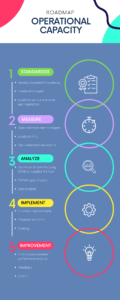Welcome to this focused discussion on Operational Capacity, a critical factor for enhancing efficiency and productivity across organizations.
This article aims to provide a concise yet thorough understanding of methodologies employed in industrial engineering for capacity assessment and optimization.
Whether you are a business manager, owner, or scholar, the insights offered here are designed to enable informed decision-making for improved resource utilization and process efficacy.
Roadmap to Optimal Capacity: A Five-Step Framework
Phase 1: Standardize
Objective:
Establish a uniform set of operations to create a stable foundation for measurement and improvement.
Key Activities:
- Develop Standard Operating Procedures (SOPs) for all key processes.
- Involve employees in the standardization process for real-world applicability.
- Use time-motion studies to establish the standard time for each operation.
Phase 2: Measure
Objective:
Collect data on current operations to establish baseline performance metrics.
Key Activities:
- Set up data collection methodologies, including both manual and automated tracking systems.
- Establish key performance indicators (KPIs) such as efficiency and utilization ratios.
- Document baseline metrics for future comparisons.
Phase 3: Analyze
Objective:
Examine the collected data to identify bottlenecks, inefficiencies, and opportunities for improvement.
Key Activities:
- Use Value Stream Mapping (VSM) to visualize the flow of materials and information.
- Perform gap analysis to understand the differences between current and desired operational capacity.
- Utilize data analytics tools to dive deeper into operational metrics.
Phase 4: Implement
Objective:
Execute planned changes aimed at optimizing operational capacity.
Key Activities:
- Prioritize areas for improvement based on the analysis.
- Integrate technology solutions like automation or ERP systems to aid in optimizing processes.
- Conduct training sessions to ensure the workforce is aligned with new operational procedures.
Phase 5: Continuous Improvement
Objective:
Establish a cycle of ongoing assessment and adjustment to maintain optimal operational capacity.
Key Activities:
- Continuously monitor performance metrics.
- Implement feedback loops for real-time adjustments.
- Revisit and update SOPs and other process documentation to adapt to evolving operational needs.
By methodically progressing through these phases, you lay down a structured path that will lead you from your current state to a more optimized level of operational capacity, giving your business a significant edge in today’s competitive landscape.
Standardization of Operations as a Baseline for Capacity Assessment
The Imperative of Operational Uniformity
Standardization serves as the foundational element in the assessment and management of operational capacity.
Creating a uniform set of operations simplifies the measurement and comparison of different variables within the system, thereby offering a reliable baseline for analysis.
Also, you can’t measure “Chaos”. To make a good analysis, you need good data. With standardization, you create a controlled environment where each variable is defined and consistent.
This ensures that the data you collect is both reliable and valid, providing you with actionable insights.
Essentially, standardization removes the “noise” associated with chaotic or inconsistent systems, enabling you to accurately identify trends, make meaningful comparisons, and ultimately, make well-informed decisions for optimizing operational capacity.
Standardized operations serve as a solid foundation upon which sophisticated analytical methods can be reliably applied.
How to Standardize Operations?
Standardizing operations isn’t just a one-off task but rather an ongoing process that involves multiple steps and stakeholders.
Below are some effective approaches to achieving operational standardization:
- Create Standard Operating Procedures (SOPs)
Begin by developing Standard Operating Procedures that outline the most efficient way to perform each task. This will serve as the “manual” that employees can refer to, ensuring that everyone is on the same page when it comes to executing operations.
- Employ the Kaizen Approach (Lean tool)
Kaizen, the Japanese term for “change for the better,” is an approach that involves continuous improvement. Encourage teams to regularly review operations and suggest improvements to the SOPs. This ensures that your operations not only become standardized but also continuously optimized
- Conduct Observations and Time Studies
Industrial engineers often perform time-motion studies or work sampling to understand how long each task should take and what the best sequence of actions is. Observational studies can help you establish the standard time for each operation, as discussed in the next subsection.
- Involve Employees in the Standardization Process
Employees who are involved in day-to-day operations often have the best understanding of the tasks at hand. Their input can be invaluable in both creating and refining SOPs, as well as in identifying potential areas for improvement.
Your business is subcontracting pieces and you’re always making new parts? Try using modular conception to standardize your products as much as possible.
This way, you can capitalize on commonalities among different parts, leading to streamlined manufacturing processes, reduced lead times, and more efficient utilization of resources.
Modular design allows for easier scalability and adaptability, as you can mix and match standardized modules to create new variations without having to design every new piece from scratch.
This not only reduces the complexity of your operations but also offers cost-saving advantages, as you can produce modules in larger quantities and maintain lower inventory levels.
Standardizing through modular conception thus enhances both operational capacity and agility.
Calculating Standard Time for Operations
Establishing the standard time for each operation is crucial for accurate capacity measurement.
Methods often employed for this include time-motion studies and work sampling, which serve to quantify the time required for each standardized unit of work.
This standard time becomes the key metric upon which subsequent capacity calculations and optimizations are based.
Understanding and implementing these initial steps sets the stage for an in-depth evaluation of your operational capacity, facilitating informed decisions aimed at boosting efficiency and throughput.
Quantitative Assessment of Operational Capacity
Capacity Formulation Using Standard Time
With the standard time for each operation established, the next logical step is to quantitatively assess the system’s operational capacity.
This can be simply calculated by dividing the total available work time by the standard time per unit operation.
However, this serves as an ideal capacity metric and may need to be adjusted for real-world constraints.
Incorporating Real-World Variables
In practice, operational capacity is seldom fully realized due to unforeseen factors such as machine downtime, employee breaks, and other operational interruptions.
It is crucial to adjust the ideal capacity by accounting for these factors to derive a more accurate, real-world capacity metric.
This is often done by incorporating efficiency and utilization ratios into the calculation.
What are efficiency and utilization ratios?
Efficiency and utilization ratios are key performance indicators commonly used in industrial engineering and operations management to evaluate how well resources are being used within a system. Here’s a brief look at what each entails:
- Efficiency Ratios
Efficiency ratios measure how effectively a system transforms inputs into outputs. For instance, in a manufacturing environment, an efficiency ratio could compare the standard time needed to produce a unit with the actual time spent. The closer this ratio is to 1, the more efficient the operation. It can be calculated as follows:
Efficiency can also be considered for a whole system, like a production line, by comparing the total output to the maximum possible output in a given period.
- Utilization Ratio
Utilization ratios evaluate how intensely a resource is being used. In a manufacturing context, machine utilization could be defined as the amount of time a machine is running versus the total available time. A high utilization ratio indicates that the machine is being used effectively, while a low ratio suggests that the machine spends a lot of time idle. The formula for machine utilization might look like this:
For labor, utilization can be assessed by comparing the actual hours worked to the total available working hours.
Both efficiency and utilization ratios offer valuable insights into operational performance but serve different purposes. While efficiency ratios are more concerned with the quality of output given the input, utilization ratios focus on the extent to which resources are being engaged.
Pushing your Analysis Further: Value Stream Mapping
Value Stream Mapping (VSM) can be an invaluable tool for visualizing the flow of materials and information through the system.
This helps to identify areas where inefficiencies or interruptions occur, such as bottlenecks, wastage, or delays.
The efficiency and utilization ratios, when considered alongside the insights gained from VSM, offer a comprehensive view of your operational landscape.
This multifaceted approach enables a more nuanced understanding and subsequently allows for the implementation of more effective optimization strategies.
In a Value Stream Mapping (VSM) exercise, calculating the Overall Equipment Effectiveness (OEE) can provide a comprehensive measure of how well your manufacturing operations are performing.
OEE is a standard metric used to quantify the effectiveness of a production process by considering its availability, performance, and quality.
By calculating OEE, you can identify areas for improvement and more precisely quantify the effectiveness of changes made to a system.
Incorporating OEE into your VSM provides an additional layer of granularity, allowing you to pinpoint inefficiencies not just at the process level, but also at the individual machine or equipment level.
This can be especially beneficial when you’re looking to optimize operational capacity, as it allows you to target specific areas where availability, performance, or quality may be falling short of potential, thereby impacting your overall capacity.
In summary, OEE serves as a critical metric that complements the broader analysis provided by Value Stream Mapping, making the assessment of operational capacity more holistic and data-driven.
Scenario-Based Modeling for Capacity Planning
Deterministic and Stochastic Models
Once the real-world operational capacity has been ascertained, scenario-based modeling becomes the next focal point.
Two main types of models are often employed: deterministic, where outcomes are precisely determined through known relationships among states and events, and stochastic, where some variables can only be described by probability distributions.
Each model serves different purposes and provides varying degrees of insight into system behavior under certain conditions.
Utilization of Modeling Tools
For effective scenario-based modeling, a range of specialized software tools are available.
These tools can simulate various scenarios, providing valuable data that can inform better decision-making.
This step is especially relevant for complex systems or processes where manual calculations become impractical or highly time-consuming.
Strategic Optimization of Operational Capacity
Optimization Techniques
After the establishment of standardized operations, capacity assessment, and scenario-based modeling, the focus shifts to optimization.
Techniques such as Linear Programming (LP) and Integer Programming can be utilized to strategically allocate resources.
These mathematical methods help in determining the optimal way to achieve desired outcomes like maximized throughput or minimized cost.
Continuous Improvement and Adaptability
The landscape of business operations is constantly evolving, necessitating an ongoing approach to capacity optimization.
Continuous improvement models such as the Plan-Do-Check-Act (PDCA) cycle or Six Sigma methodologies can be applied to regularly reassess and recalibrate operational capacity.
This ensures that the system remains adaptive to changing conditions and is continually optimized for performance.
Conclusion
Operational capacity serves as a critical linchpin in the overarching framework of organizational efficiency and productivity. Through a systematic approach that commences with the standardization of operations and culminates in strategic optimization, managers, business owners, and scholars can not only understand but also significantly improve the functioning of their respective systems.
The methodologies detailed herein—ranging from establishing standard time for operations to employing scenario-based modeling and optimization techniques—are integral for making data-driven, informed decisions. When these elements are harmoniously integrated and regularly updated to adapt to changing conditions, the organization stands to achieve sustainable performance improvements.
In summary, mastering the intricacies of operational capacity provides a strategic advantage in a competitive business landscape, equipping organizations with the tools and insights necessary for excellence in both operational efficiency and long-term planning.
Key Takeaways
- Standardization as a Baseline: Establishing uniform operations and calculating standard time are foundational steps for accurate capacity assessment.
- Quantitative Capacity Assessment: Ideal capacity calculations based on standard time should be adjusted to incorporate real-world variables, providing a more accurate metric for operational planning.
- Scenario-Based Modeling: Employ deterministic and stochastic models to understand how your system behaves under varying conditions, enabling better preparedness and planning.
- Strategic Optimization: Techniques such as Linear Programming can be employed for effective resource allocation, serving as advanced methods to enhance operational capacity.
- Continuous Improvement: Implement ongoing assessment models like PDCA or Six Sigma to ensure that your operations remain optimized and adaptable to evolving business conditions.









